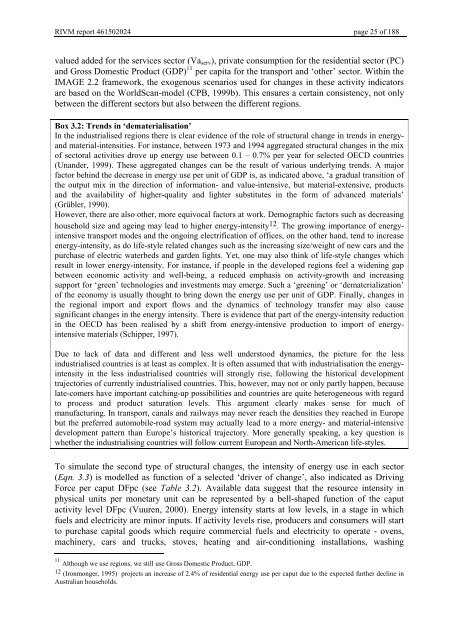Targets IMage Energy Regional (TIMER) Model, Technical ...
Targets IMage Energy Regional (TIMER) Model, Technical ...
Targets IMage Energy Regional (TIMER) Model, Technical ...
Create successful ePaper yourself
Turn your PDF publications into a flip-book with our unique Google optimized e-Paper software.
RIVM report 461502024 page 25 of 188<br />
valued added for the services sector (Va serv ), private consumption for the residential sector (PC)<br />
and Gross Domestic Product (GDP) 11 per capita for the transport and ‘other’ sector. Within the<br />
IMAGE 2.2 framework, the exogenous scenarios used for changes in these activity indicators<br />
are based on the WorldScan-model (CPB, 1999b). This ensures a certain consistency, not only<br />
between the different sectors but also between the different regions.<br />
%R[7UHQGVLQµGHPDWHULDOLVDWLRQ<br />
In the industrialised regions there is clear evidence of the role of structural change in trends in energyand<br />
material-intensities. For instance, between 1973 and 1994 aggregated structural changes in the mix<br />
of sectoral activities drove up energy use between 0.1 – 0.7% per year for selected OECD countries<br />
(Unander, 1999). These aggregated changes can be the result of various underlying trends. A major<br />
factor behind the decrease in energy use per unit of GDP is, as indicated above, ‘a gradual transition of<br />
the output mix in the direction of information- and value-intensive, but material-extensive, products<br />
and the availability of higher-quality and lighter substitutes in the form of advanced materials’<br />
(Grübler, 1990).<br />
However, there are also other, more equivocal factors at work. Demographic factors such as decreasing<br />
household size and ageing may lead to higher energy-intensity 12 . The growing importance of energyintensive<br />
transport modes and the ongoing electrification of offices, on the other hand, tend to increase<br />
energy-intensity, as do life-style related changes such as the increasing size/weight of new cars and the<br />
purchase of electric waterbeds and garden lights. Yet, one may also think of life-style changes which<br />
result in lower energy-intensity. For instance, if people in the developed regions feel a widening gap<br />
between economic activity and well-being, a reduced emphasis on activity-growth and increasing<br />
support for ‘green’ technologies and investments may emerge. Such a ‘greening’ or ‘dematerialization’<br />
of the economy is usually thought to bring down the energy use per unit of GDP. Finally, changes in<br />
the regional import and export flows and the dynamics of technology transfer may also cause<br />
significant changes in the energy intensity. There is evidence that part of the energy-intensity reduction<br />
in the OECD has been realised by a shift from energy-intensive production to import of energyintensive<br />
materials (Schipper, 1997).<br />
Due to lack of data and different and less well understood dynamics, the picture for the less<br />
industrialised countries is at least as complex. It is often assumed that with industrialisation the energyintensity<br />
in the less industrialised countries will strongly rise, following the historical development<br />
trajectories of currently industrialised countries. This, however, may not or only partly happen, because<br />
late-comers have important catching-up possibilities and countries are quite heterogeneous with regard<br />
to process and product saturation levels. This argument clearly makes sense for much of<br />
manufacturing. In transport, canals and railways may never reach the densities they reached in Europe<br />
but the preferred automobile-road system may actually lead to a more energy- and material-intensive<br />
development pattern than Europe’s historical trajectory. More generally speaking, a key question is<br />
whether the industrialising countries will follow current European and North-American life-styles.<br />
To simulate the second type of structural changes, the intensity of energy use in each sector<br />
((TQ) is modelled as function of a selected ‘driver of change’, also indicated as Driving<br />
Force per caput DFpc (see 7DEOH ). Available data suggest that the resource intensity in<br />
physical units per monetary unit can be represented by a bell-shaped function of the caput<br />
activity level DFpc (Vuuren, 2000). <strong>Energy</strong> intensity starts at low levels, in a stage in which<br />
fuels and electricity are minor inputs. If activity levels rise, producers and consumers will start<br />
to purchase capital goods which require commercial fuels and electricity to operate - ovens,<br />
machinery, cars and trucks, stoves, heating and air-conditioning installations, washing<br />
11 Although we use regions, we still use Gross Domestic Product, GDP.<br />
12 (Ironmonger, 1995) projects an increase of 2.4% of residential energy use per caput due to the expected further decline in<br />
Australian households.
















